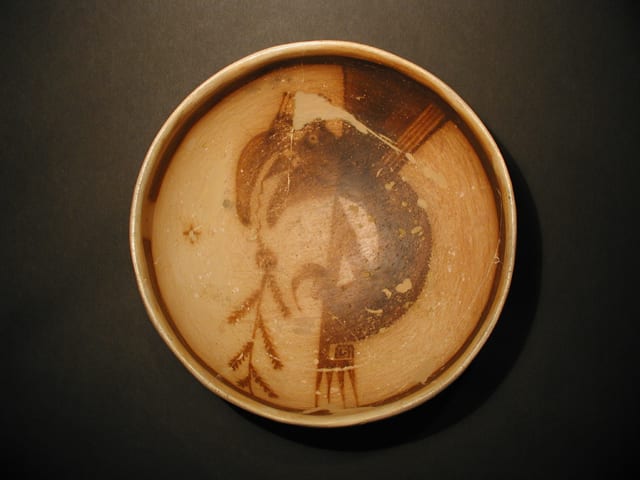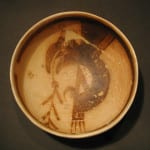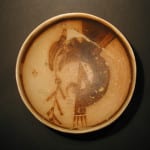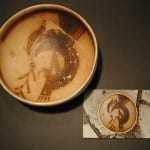Jeddito Pot with a flying germination creature framed by a break line, unpainted exterior. Jeddito was the most common ceramic style in the northeastern Arizona area from A.D 1325 to A.D. 1600.
The image on 1997-05 is similar to a bowl excavated in 1896 by J. Walter Fewkes at Old Cunopavi on Second Mesa (Fewkes, 1898b: Plate L following p. 539. See also, Fewkes, 1904:114). Fewkes describes the creature as a “plumed serpent.” The images on 1997-03 and the bowl excavated in 1896 are perhaps a variation of the pueblo Avanyu and the Mesoamerican Quetzalcoatl, beings that gave birth to rain and lightening and whose voice is thunder.
It is from this style of pottery that the Sikyatki style developed, with the addition of a yellow clay (red on firing) color in the decoration. After A.D. 1600, under the influence of the Spanish , the Jeddito tradition was lost eventually to be replaced by Zuni-inspired white slipware called “Polacca ware.” (For Polacca pots in the collection, see the Category List.) It was the older Jeddito tradition, specifically the Sikyatki variant, which Nampeyo used as a model for her own work, beginning in the 1880s. For example, see 1994-15 for a second Jeddito bowl in the collection, one with a spiral feather design that Nampeyo revived as the classic model for her Sikyatki Revival style pottery.
Of course, we cannot know what specifically was in the mind of the potter who created this piece 500 or more years ago. The power of the image, however, speaks loudly. The image is carefully drawn and fits the pot well. The asymmetry of the design (so favored by Nampeyo hundreds of years later) give the image terrific motion and power. The bird creature seems ready to spring off the surface of the ceramic. Emerging from the creature’s tongue and issuing from its mouth is the stem of a plant Off the beak of the creature is a cross that might represent a star. One imagines celestial forces, seasons and germination. This sensibility, it seems to me, ties it to the function of the simple medicine bowl (1992-10) and (I think) the more modern “germination pot,” (2001-04). See also, 1987-03 and 1989-04. For a relatively modern bowl (ca.1910-1920) owned by the Museum of Northern Arizona that incorporates many of the design elements and the energy of 1997-05, see Allen (1984:44, pot E2006).
I asked Steven A. LeBlanc, co author of Symbols in Clay, an analysis of Jeddito ware, if he thought my interpretative comments about the design of 1997-05 were “out of line.” He responded:
———-
“I resist very hard trying to read ancient minds. I am asked all the time to do it. I try instead to see what we can learn about the context of making the image than what they were thinking. I think the key thing in this case (bowl 1997-05) is that the image was very ‘loaded.’ Think of a social situation where the painter was allowed to paint it, and not considered a witch when they did. A young girl? Highly unlikely. An old man who was a religious leader? Much more likely. That is the approach I take with the images and stay away with what was in their mind.” [Personal email, 7/14/09, on file]
———-
I saw pot 1997-05 offered for sale at Cowboys and Indians Antiques in Albuquerque, though it was owned by Mark Sublette of Tucson. Although the exterior showed prior cracking and repair, the interior was extraordinarily clean and complete, an odd disjuncture. I called Mark in Tucson and we agreed to have the pot examined by Andy Goldschmidt in Corrales. Before testing the bowl Andy took a photograph of the clean and complete interior, reprinted here. When he applied acetone to the interior, all of the interior surface paint dissolved, leaving the original A.D. 1500 (?) paint and image. Apparently an earlier restorer had repaired the pot and, using the original design as a guide, had repainted the image. The pot now shows its original prehistoric paint.
For a modern pot that uses the same design as 1997-05, see plaque/bowl by Rachel Sahmie, 2010-12.






